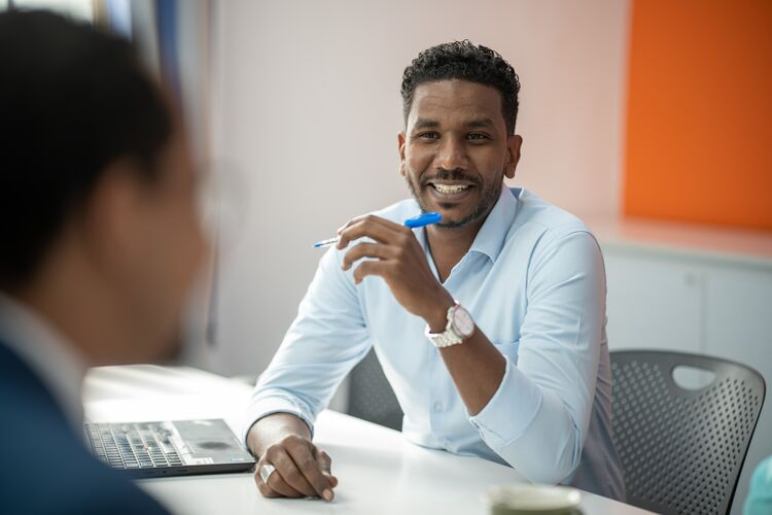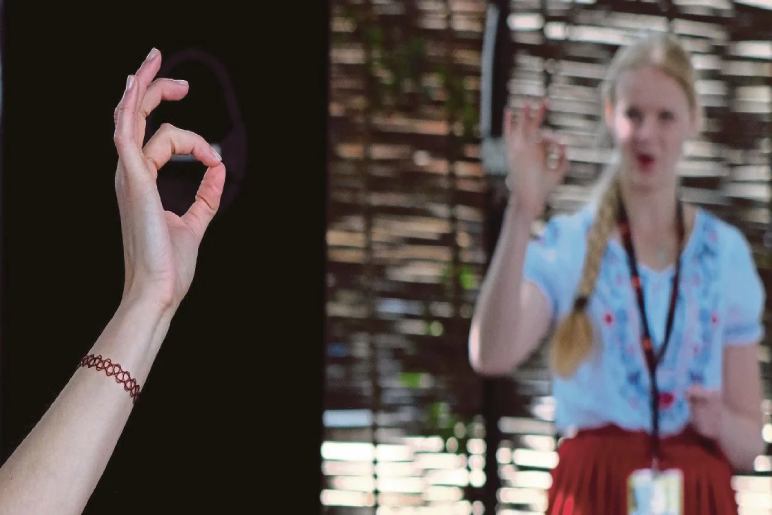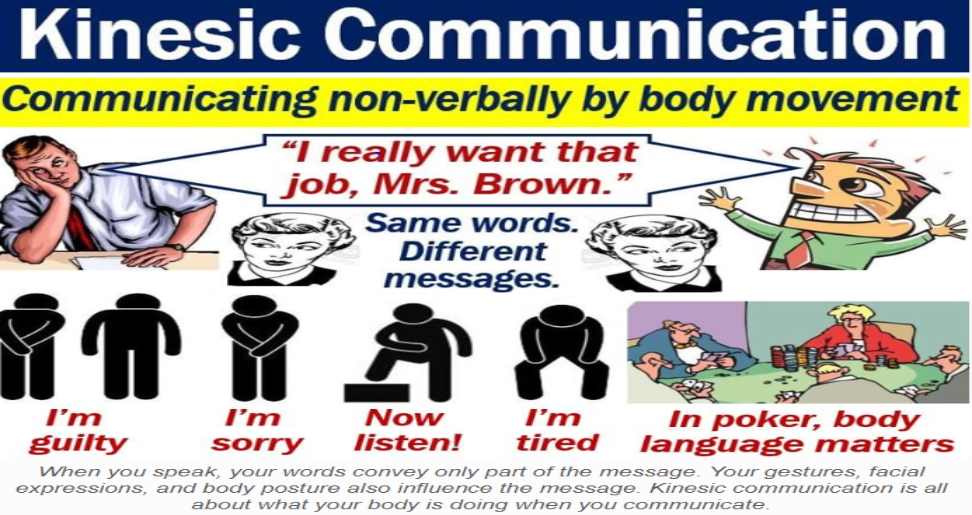Have you ever wondered how much of your message is actually conveyed through your words? Surprisingly, it’s only a small part. The rest is communicated through your body, your face, and your voice. This silent language is called kinesics.
What is Kinesics?

Kinesics is the study of body language. It’s about understanding the unspoken messages we send through our movements, gestures, facial expressions, and posture. It’s like learning to read between the lines of a conversation.
Why Kinesics Matters: The Unspoken Language

We often think of communication as solely about words, but the truth is, our bodies speak volumes. Kinesics, the study of body movement as a form of communication, reveals a world of unspoken messages. Why is it so important? Let’s dive in.
Your Body, Your Message
Our bodies are constantly sending signals. From the subtle tilt of our head to the position of our arms, every movement carries meaning. Kinesics helps us:
- Understand others better: By observing someone’s body language, we can gain insights into their true feelings and intentions. Are they confident or nervous? Interested or bored? Their body will often reveal the answers.
- Express ourselves effectively: Our body language can reinforce or contradict our words. A confident posture, for example, can make us appear more credible.
- Build stronger connections: When we’re attuned to both verbal and nonverbal cues, we can create deeper connections with others.
The Power of Nonverbal Cues
Research shows that a significant portion of communication is nonverbal. Our bodies often convey messages more honestly than our words. For instance, a forced smile might not match the sadness in someone’s eyes. Kinesics helps us:
- Detect deception: Inconsistencies between verbal and nonverbal cues can be a red flag.
- Improve relationships: By understanding and responding to nonverbal signals, we can strengthen our bonds with others.
- Enhance leadership: Effective leaders use body language to inspire and influence.
Kinesics: The Silent Language That Shapes Our World

We often overlook the power of nonverbal communication. Kinesics, the study of body language, reveals a hidden layer of meaning in every interaction. From the subtle twitch of a brow to the confident stance of a leader, our bodies are constantly sending signals.
Beyond Words
Why is kinesics so crucial?
- Authenticity: Body language often reveals our true feelings, even when our words try to mask them.
- Connection: A shared understanding of nonverbal cues fosters deeper connections.
- Influence: Effective leaders and communicators master the art of body language to persuade and inspire.
- Understanding: By observing others’ body language, we can gain valuable insights into their thoughts and emotions.
A World of Possibilities
Kinesics has applications in various fields:
- Business: Successful negotiations and sales often hinge on understanding body language.
- Healthcare: Doctors and therapists can use kinesics to assess patients’ conditions and emotional states.
- Law enforcement: Detecting deception through body language is a crucial skill for investigators.
- Education: Teachers can use body language to engage students and create a positive learning environment.
Mastering the Art
To improve your kinesics skills:
- Observe: Pay attention to the body language of others.
- Practice: Be conscious of your own body language and how it impacts your communication.
- Learn: There are countless resources available to deepen your understanding of kinesics.
Types of Kinesics

Kinesics can be broken down into several categories:
- Facial expressions: Your face is the most expressive part of your body. It can convey a wide range of emotions, from happiness and sadness to anger and surprise.
- Gestures: These are movements of your hands, arms, and body. They can be intentional or unintentional. For example, pointing can indicate direction, while waving goodbye is a deliberate gesture.
- Posture: The way you hold your body can communicate a lot about how you’re feeling. Good posture can convey confidence, while slouching might suggest boredom or lack of interest.
- Eye contact: Your eyes are powerful tools for communication. Maintaining eye contact can show interest and engagement, while avoiding eye contact might indicate shyness or dishonesty.
- Haptics: This refers to touch. Physical contact can convey different messages depending on the situation. A handshake can be formal, while a hug can be intimate.
Improving Your Kinesics: Speak Volumes Without Saying a Word

We’ve all heard the saying, “actions speak louder than words.” This is where kinesics comes in. It’s the silent language of your body, and mastering it can significantly enhance your communication skills. Here’s how to improve your kinesics:
Be Mindful of Your Body Language
- Posture: Stand tall and confident. Good posture exudes confidence and authority.
- Gestures: Use gestures to emphasize your points, but avoid excessive movements.
- Facial Expressions: Let your face reflect your emotions authentically. A genuine smile can go a long way.
- Eye Contact: Maintain eye contact to show engagement and interest.
Observe Others
Pay attention to how others use body language. You can learn a lot by observing successful communicators.
Practice Active Listening
When engaging in conversations, focus on the speaker’s nonverbal cues. This helps you understand their message better and respond appropriately.
Seek Feedback
Ask trusted friends or colleagues for honest feedback on your body language. Constructive criticism can be invaluable.
Record Yourself
If possible, record yourself speaking. Watch the playback to identify areas for improvement.
Be Authentic
The most effective body language is genuine. Don’t try to force it. Let your body language naturally reflect your thoughts and feelings.
Build Self-Awareness
Record yourself interacting with others to identify patterns in your body language. Are you crossing your arms unconsciously? Do you maintain eye contact? Self-awareness is the first step to improvement.
Incorporate Kinesics into Daily Life
Every interaction is an opportunity to practice. Be mindful of your body language in professional, social, and personal settings.
The Nuances of Kinesics

Cultural Variations in Kinesics
One of the most fascinating aspects of kinesics is its diversity across cultures. A gesture or facial expression that conveys one meaning in one culture might have a completely different interpretation in another. For instance:
- Eye contact: In Western cultures, direct eye contact is often seen as a sign of confidence and honesty. However, in many Asian cultures, prolonged eye contact can be considered disrespectful.
- Gestures: The “thumbs up” gesture is generally a positive sign in Western countries, but it can be offensive in some Middle Eastern cultures.
- Personal space: The distance people maintain between each other varies widely across cultures.
Understanding these cultural differences is essential for effective intercultural communication.
Kinesics and Deception Detection
Kinesics plays a significant role in detecting deception. While it’s important to note that no single gesture or behavior is a definitive indicator of lying, certain inconsistencies between verbal and nonverbal cues can raise red flags. For example:
- Microexpressions: Brief, involuntary facial expressions that can reveal true emotions.
- Incongruent gestures: When someone’s body language doesn’t match their words, it could be a sign of deception.
- Eye contact avoidance: Excessive or insufficient eye contact can be indicative of dishonesty.
However, it’s crucial to approach deception detection with caution, as cultural differences, individual variations, and false positives can occur.
Kinesics in Different Contexts
Kinesics is not limited to face-to-face interactions. It’s also essential in:
- Public speaking: Effective speakers use body language to engage their audience and enhance their message.
- Job interviews: Body language can significantly impact an interviewer’s impression of a candidate.
- Sales and marketing: Understanding customer body language can help sales professionals build rapport and close deals.
- Online communication: Even in digital interactions, nonverbal cues like emojis and avatars can convey meaning.
Conclusion

Kinesics is a fascinating aspect of human communication. By understanding and using body language effectively, you can improve your relationships, your career, and your overall communication skills. Remember, your body is constantly sending messages, so make sure they’re the right ones!
Read more:
- The Importance of Timely Fleet Vehicle Service
- Alternatives to Payday Loans: Exploring Your Options
- Benefits of Selling Your Decommissioned Data Center Equipment
Featured Image source: https://tinyurl.com/y2ssp89p

